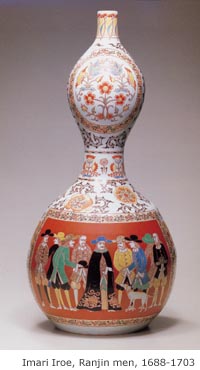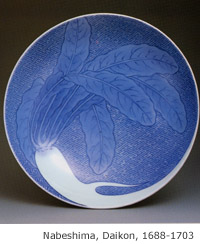
Imari-ware was the first porcelain produced in Japan, in about 1600. Porcelain is made from extremely fine white clay that is fired to very high temperatures. Korean potters established workshops and kilns in an area known as Akae-machi in the town of Arita, Saga prefecture, Kyushu. However, the name of the ceramics is drawn from the nearby port town of Imari. It was from here that the Arita pottery was exported to the world and became widely known. The work is noted for its colored glazes, red in particular and intricately painted patterns. This style of Imari and Nabeshima ware has become known as 'Iro-e' or 'Aka-e' style (colored/red painting), of the same name as the village, Akae, where the practitioners of this colored technique lived.

A fine example of Imari Iro-e ware at the museum is the 'Ranjin-Men' vase made in the late 1600's. The double bulbed, gourd-like vase stands over 70 cm tall and is decorated in elaborate floral patterns. Painted predominately in red glaze the brilliantly colored piece includes black, blue, green and yellow glazing. On the main section, two panels depict European gentleman traders and their three master sailing ship. In 1658, the Dutch East India Company began exporting large quantities of Imari ware throughout Asia and Europe. A year later the Company had orders for over 56,000 pieces as the popularity of the porcelain was expanding all over the world. Many of the significant pieces on display at the museum were collected by Kurita in Europe.
The only other variety of ceramics at the museum, Nabeshima-ware, was also produced in northwestern Kyushu but in separate kilns controlled by the Lord of the Nabeshima clan. They established workshops and kilns at the Nihonyanagi, Okochiyama, Imari city, and a short distance from the Arita workshops. Imari ware was produced for the local and export market. In contrast, Nabeshima ware was produced exclusively by the Nabeshima clan as gifts for the Shogunate, Imperial Family and other clan lords.
For over 300 years the Nabeshima Lords retained tight control over the Aka-e glazing technique developed and used in both the Nabeshima and Imari 'Iroe' (colored) ware. Apparently so strict was this control that he would not even allow his own clan artisans use the technique at their Nabeshima workshops in Okochiyama. He insisted on his own clan's porcelain, which required this decorative glazing work, to be taken to Akae-machi, Arita for this process.

A 20 cm plate with peaches and blossom painted on it in a blue glaze is a fine example of Nabeshima ware in the Kurita collection. Although Nabeshima ware was made solely for the elite classes, they were usually simple dishes for food rather than the highly sculptural and decorative pieces of its nearby Imari ware cousin. Nabeshima ware was decorated with highly refined yet simple and poetic images of designs from nature. Various plates are inspired depictions of common vegetables such as Daikon and various fruit blossoms as well as everyday scenes such as boys throwing snowballs.

Besides the extensive collection, the Kurita museum includes a special History Hall, a six-story building covered inside and out in Arita porcelain tiles. There is also a memorial building dedicated to 'the unknown potters', with observation area and statue of Jibo-kannon on the roof. A special exhibition hall and coffee shop, Porcelain Research center, complete with outdoor 'climbing kiln', a huge shop with a large selection of Imari ware and many reproductions of examples from the Kurita collection for sale. There is also an excellent Japanese restaurant in an old, 1733 farmhouse building moved to the museum site. Also within the park-like setting of the museum are temples, old cemeteries, sculptures and other historic buildings.
A complete visit to the Kurita Museum takes at least a full afternoon and is a rewarding and enjoyable experience wandering around the elegant wooded gardens. However, for those with time to explore the area a little more, a visit to the Ashikaga Gakko, the oldest university in Japan and the nearby Banna-ji Temple, both in Ashikaga-shi are worthwhile excursions.
Kurita Museum Imari and Nabeshima Porcelain
1542 Komaba-cho, Ashikaga-shi Tochigi-ken
Tel: 0284.91.1026 10:00 Ð17:00
Adults Y 1,550 Children Y520
JR Tohoku-honzen Line (Oyama) change to Ryomo Line (Tomita) 10 min walk. Or Tobu Line (Ashikaga) (three buses per day, 15 mins by taxi, or change to JR Ryomo Line (Tomita)